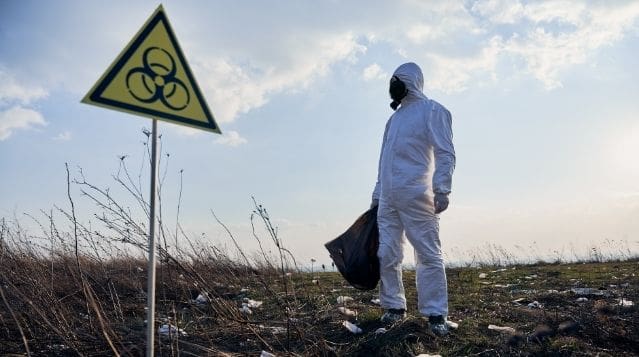Biological hazard inspection
The inspection of biological hazards is a critical component in ensuring safety and compliance within various sectors such as healthcare, food processing, pharmaceuticals, and industrial facilities. Biological hazards encompass a wide range of pathogenic agents including bacteria, viruses, fungi, and other microorganisms that can pose significant risks to human health.
Our laboratory specializes in conducting comprehensive inspections to identify and mitigate these hazards. Our team utilizes advanced techniques and methodologies prescribed by international standards such as ISO 14698 for air sampling or EN 29234 for surface swabbing, ensuring that our findings are reliable and actionable.
The first step in this process involves a thorough site assessment to identify potential sources of contamination. This includes evaluating the design and layout of facilities, identifying high-risk areas, and understanding the operational processes that could lead to biological hazards. Once these risks are identified, we proceed with targeted sampling. For air sampling, we use filtration systems compliant with ISO 17834:2016, while for surface swabs, we adhere to EN 29234 which specifies methods for the collection of microorganisms from surfaces.
Sample preparation is crucial in ensuring accurate results. Samples are transported under controlled conditions and processed promptly to maintain their integrity. Depending on the type of sample—whether it's air, surface swabs, or liquid—we employ specific protocols that follow ISO standards to ensure consistency and reliability. Once prepared, these samples undergo analysis using state-of-the-art equipment such as PCR machines for nucleic acid detection or electron microscopes for detailed imaging.
The analytical phase involves not only identifying the presence of pathogens but also quantifying them if necessary. This helps in understanding the levels of contamination and informs risk management strategies. Our laboratory uses methods aligned with ASTM E2318-05(2020) for quantitative analysis, providing precise data that can be used to make informed decisions.
After completing all analyses, our team compiles a detailed report outlining findings and recommendations. The report includes not only the results of tests but also insights into how these findings relate to broader EHS considerations. Recommendations are tailored specifically to your organization's needs, helping you implement effective control measures that align with regulatory requirements like OSHA 1910.26 or EU Directive 2004/85/EC.
Our approach is designed to provide peace of mind by ensuring that biological hazards are proactively managed rather than reactively addressed after incidents occur. By leveraging our expertise and adhering strictly to established protocols, we help organizations maintain a safe environment while also contributing positively towards sustainability goals.
Why It Matters
The significance of conducting regular biological hazard inspections cannot be overstated in today’s world where infectious diseases continue to pose threats both locally and globally. In healthcare settings, preventing the spread of pathogens is paramount not only for patient safety but also for maintaining public trust.
In food processing plants, ensuring that all stages from raw materials intake through packaging are free from harmful microorganisms protects consumers from foodborne illnesses. Similarly, in pharmaceutical manufacturing environments, strict adherence to good manufacturing practices (GMP) ensures product quality and reliability.
For industrial facilities dealing with biological waste or hazardous chemicals, proper handling and disposal procedures must be rigorously followed to prevent accidents that could result in severe health impacts for employees and the surrounding community. Compliance with regulations like OSHA 1910.26 further underscores this necessity by mandating specific actions aimed at protecting workers’ health.
Moreover, from an environmental perspective, minimizing biological contamination helps preserve natural ecosystems by reducing unnecessary introductions of invasive species or pollutants into sensitive habitats. This aligns well with broader sustainability initiatives focused on safeguarding biodiversity and promoting responsible resource use.
Benefits
Conducting regular biological hazard inspections brings numerous benefits to organizations across different sectors:
- Promotes Safety: By identifying potential hazards early, you can take corrective actions before they escalate into full-blown crises.
- Avoids Legal Penalties: Compliance with relevant regulations helps avoid costly fines and legal repercussions associated non-compliance.
- Enhances Reputation: Demonstrating commitment to safety and quality improves your company’s image among customers, stakeholders, and regulators alike.
- Reduces Operational Costs: Preventive measures often prove less expensive than reactive ones when addressing issues like product recalls or facility shutdowns due to health scares.
- Supports Continuous Improvement: Regular inspections provide valuable feedback that can be used to enhance existing protocols and introduce new best practices.
- Fosters Employee Morale: Knowing that safety measures are in place boosts employees’ confidence, making them feel more secure at work.
All these advantages contribute significantly towards creating a safer working environment while also supporting sustainable development efforts.
Environmental and Sustainability Contributions
Incorporating biological hazard inspections into your overall EHS strategy plays an integral role in contributing positively to environmental sustainability:
- Reduces Ecological Impact: By preventing the release of harmful substances into the environment, you help maintain ecological balance.
- Minimizes Waste Generation: Effective management of biological waste reduces overall waste generation and eases disposal challenges.
- Promotes Responsible Resource Use: Ensuring that resources are used efficiently helps minimize waste and supports sustainable resource management practices.
- Safeguards Biodiversity: Controlling the spread of invasive species or pathogens preserves local ecosystems and contributes to biodiversity conservation efforts.
These contributions align with broader sustainability goals, demonstrating your organization’s commitment to responsible stewardship of natural resources.





